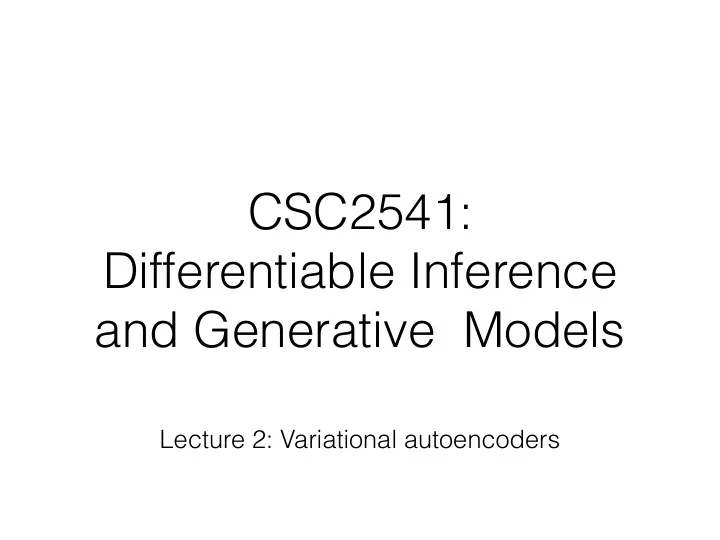

CSC2541: Differentiable Inference and Generative Models Lecture 2: Variational autoencoders
Admin: • TAs: • Tony Wu (ywu@cs.toronto.edu) • Kamal Rai (kamal.rai@mail.utoronto.ca) • Extra seminar: Model-based Reinforcement learning • Seminar sign-up
Seminars • 7 weeks of seminars, about 8-9 people each • Each day will have one or two major themes, 3-6 papers covered • Divided into 2-3 presentations of about 30-40 mins each • Explain main idea, relate to previous work and future directions
Computational Tools • Automatic differentiation • Neural networks • Stochastic optimization • Simple Monte Carlo
Computational Tools • Can specify arbitrarily-flexible functions with a deep net: y = f θ ( x ) • Can specify arbitrarily complex conditional distributions with a deep net: p ( y | x ) = N ( y | µ = f θ ( x ) , Σ = g θ ( x )) • Density networks: p ( y = c | x ) = 1 exp([ f θ ( x )] c ) Z θ Z p ( y | x ) = f θ ( x ) p ( θ ) d θ • Bayesian neural network:
Computational Tools • Can optimize continuous parameters wrt any objective given unbiased estimates of its gradient. • given E p ( x ) [ grad ( J )( θ , x )] = r θ J ( θ ) • can use: ˆ θ = SGD( θ init , ˆ grad(J)) ≈ argmin θ ( J )
Computational Tools • Can differentiate any deterministic, continuous function using reverse-mode automatic differentiation (backprop) • Cost of evaluating gradient about same as evaluating function
Computational Tools • Simple Monte Carlo gives unbiased estimates of integrals given samples
Benefits of Bayesianism • Examples: Diagnosing disease, doing regression • Captures uncertainty • Necessary for decision-making • Why pretend we’re certain? • Automatic regularization from ensembling • Latent variables can be meaningful • Can combine datasets/models (semi-supervised learning) • Marginal likelihood automatically chooses model capacity • Inference is deterministic given model, automatic answer for hyperparameters
What is inference? p ( x | z, θ ) p ( z ) p ( z | x, θ ) = • Estimate posterior: R p ( x | z 0 , θ ) p ( z 0 ) dz 0 • Compute expectations: E p ( z | x, θ ) [ f ( z | x, θ )] Z p ( x 2 | x 1 , θ ) = p ( x 2 | z ) p ( z | x 1 , θ ) dz • Make predictions: Z • Marginal likelihood: p ( x | θ ) = p ( z ) p ( z | x, θ ) dz • Can all be estimated using samples from the posterior and Simple Monte Carlo!
From IS to Variational Inference [from Shakir Mohamed] Variational Inference Z log p ( y ) = log p ( y | z ) p ( z ) dz Integral problem p ( y | z ) p ( z ) q ( z ) Z log p ( y ) = log q ( z ) dz Proposal p ( y | z ) p ( z ) Z log p ( y ) = log q ( z ) q ( z ) dz Importance Weight ✓ ◆ p ( y | z ) p ( z ) Z log p ( y ) ≥ q ( z ) log dz Jensen’s inequality q ( z ) Z Z log p ( x ) g ( x ) dx ≥ p ( x ) log g ( x ) dx q ( z ) log q ( z ) Z Z = q ( z ) log p ( y | z ) − p ( z ) = E q ( z ) [log p ( y | z )] � KL [ q ( z ) k p ( z )] Variational lower bound Variational Inference 28
Interpretations • Bound maximized when q(z|x) = p(z|x) • Reconstruction + difference from prior • MAP + Entropy
Show demos • Toy example • Mixture example • Bayesian neural network
When we have lots of data, and global model parameters: N Y p ( x | θ ) = ( x i | z i , θ ) p ( z i ) d θ i =1 • Can alternate optimizing variational parameters, model parameters • A generalization of Expectation-Maximization • Slow because of alternating optimization - need to update q ( z i | x i , θ ) theta, then each • Slow and memory-intensive when we have many datapoints
Variational autoencoders • Model: Latent-variable model p(x|z, theta) usually specified by a neural network • Inference: Recognition network for q(z|x, theta) usually specified by a neural network • Training objective: Simple Monte Carlo for unbiased estimate of Variational lower bound • Optimization method: Stochastic gradient ascent, with automatic differentiation for gradients
Show VAE demo • Maximizing ELBO, or minimizing KL from true posterior • Relation to denoting autoencoders: Training ‘encoder’ and ‘decoder’ together • Decoder specifies model, encoder specifies inference
Pros and Cons • Flexible generative model • End-to-end gradient training • Measurable objective (and lower bound - model is at least this good) • Fast test-time inference • Cons: • sub-optimal variational factors • limited approximation to true posterior (will revisit) • Can have high-variance gradients
Questions
Class Projects • Develop a generative model for a new medium • Extend existing models, inference, or training • Apply an existing approach in a new way • Review / comparison / tutorials
Other ideas • Backprop through BEAM search • Backprop through dynamic programming for DNA alignment • Conditional GANs for mesh upsampling • Apply VAE SLDS to human speech • Generate images from captions • Learn to predict time-reversed physical dynamics • Investigate minimax optimization methods for GANS • Model-based RL (show demo)
Recommend
More recommend